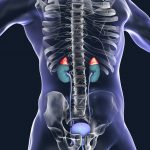A Thriving Mind & Body Ecology: Critical Factors to Consider
CHRIS D. MELETIS, ND
Thomas Edison once said, “The chief function of the body is to carry the brain around.” Indeed, the human brain’s importance is reflected in the fact that it is the most powerful computer ever created. If we bought a real computer, we’d invest in a warranty program to safeguard it. Yet, when it comes to our brains, the computers of our bodies, our patients don’t always take the same care to protect this priceless and irreplaceable possession.
Never has it been more clear that there is a bidirectional relationship between the brain and the body. A healthy mind is the fertilizer for sustaining a health-promoting neuroendocrine physiological state that allows our body, from the neck down, to remain healthy. At the same time, our bodies, when they are healthy, are a fertile ground for our minds to flourish.
The question is, how do we describe the interconnectivity of the mind-body-spirit while keeping the discussion palatable for the breadth and diversity of the belief systems of our patient community? Circa 1999, I was invited to speak to 1200 women at the Oregon Convention Center about using the holistic approach of naturopathic medicine based upon each individual patient’s journey. Residing in Portland, Oregon, and serving at the time as Dean of Naturopathic Medicine and Chief Medical Officer of the National College of Naturopathic Medicine (now known as National University of Natural Medicine) – a tour of duty that I was fortunate to serve for 7 years – I saw this as a tremendous opportunity, as I was collaborating with the local allopathic medical school on an integrative medicine National Institutes of Health (NIH) grant. Ultimately, using the following aphorism, I condensed the concept of mind, body, and spirit that we were all exposed to in our formal naturopathic medical school program into this: “The body is where the mind and spirit commune; the mind interfaces our body and spirit; and our spirit conditions the mind and body.”
This article will focus on the mind and body, and how these 2 components are more inseparable than once believed. As practitioners, we all appreciate that our brain function and conscious/subconscious perceptions are impacted by the global health of the body as a whole. I will not endeavor to tease out the differences between the anatomical brain and one’s mind, as there are far too many rabbit holes that we all could venture down together. Yes, there are still psychiatrists, psychologists, counselors, and many enlightened functional medicine providers that focus on the mind. Thus, for the sake of this discussion, we will assume that there must be sufficient anatomical integrity and physiological function of the structures we called the brain during our anatomy classes – including the cortex, basal ganglia, brain stem, and all too often the cerebellum – to allow our optimal mind to manifest.
The Fascinating Human Brain
The brain is an amazing organ. Neurons communicate with each other through synapses located on the edges of 2 side-by-side neurons that are separated by a small space. One of the neurons releases a chemical, which moves across the gap between neurons, where it triggers electrical activity in the neighboring neuron. Via this process, signals are transmitted between cells. Every second, each neuron can signal 1000 nerve impulses. At the same time, neurons can make up to tens of thousands of synaptic connections with other neurons. Table 1 lists some compelling facts that point to how broad and complex the human brain is and why limitations in how we integrate our mind and body are far from being fully understood.
Table 1: Fascinating Facts About the Brain
| The brain is made up of more than 86 billion nerves1 |
| The brain communicates via trillions of synaptic connections2 |
| The adult human brain weighs about 3 lb (1300 to 1400 g).3 Sixty-percent of the dry weight of the brain is fat.4 This means the brain has the distinction of being the body’s most fatty organ. |
| The adult human brain is about 2% of the body’s total weight. Despite its small size, the brain uses about 20% of the body’s oxygen and calories consumed.5 |
| The spinal cord is the primary communication route between the body and the brain3 |
| The brain can transmit information at a rate of up to 268 miles per hour3 |
| Every minute, the average person thinks about 48.6 thoughts6 |
| According to a national poll, two-fifths (39%) of people in the United States forgot or misplaced everyday items within the past week. Surprisingly, people ages 18-34 are more likely than seniors aged 55 and older to forget where they put their car keys, forget what day it is, or forget to bring their lunch to work.7 |
| The human brain has 400 miles of capillaries8 |
| Your eyes only need to see an image for as little as 13 milliseconds in order for your brain to process it. This is less than the blink of an eye.9 |
Fueling the Brain & Body
For the brain to work properly, the body must be well nourished. One of the most important nutrients patients can feed their bodies to encourage brain health are omega-3 fatty acids. As I noted earlier, the brain is comprised of almost 60% fat.4 It makes sense, therefore, that omega-3 fatty acids are some of the most important molecules for healthy cognitive function. Studies have associated omega-3 fatty acid deficiency with worse cognitive performance.4
Omega-3 fatty acids are also associated with optimal brain development during the fetal and postnatal periods.4 The omega-3 fatty acid, docosahexaenoic acid (DHA), is critical for the maturation of the retina and visual cortex.4 Increased DHA intake in mothers during pregnancy and the postnatal period is linked to enhanced visual acuity and mental development.4 Essential fatty acids such as omega-3s also play an important role in the synthesis and function of brain neurotransmitters and immune system molecules.4 Among postmenopausal participants in the Women’s Health Initiative Memory Study, a higher RBC omega-3 index (EPA + DHA) was found associated with greater total normal MRI brain volume and hippocampal volume, measured 8 years after the blood test was performed.10
Furthermore, increasing the ratio of omega-6 to omega-3 fatty acids appears to lead to obesity.3 Over the last 30 years, the amount of fat and saturated fat eaten as a percentage of total calories has declined in people consuming Western diets.11 At the same time, omega-6 fatty acid intake has increased while omega-3 intake has declined.11 This has led to a significant increase in the omega-6/omega-3 ratio, from 1:1 in our ancestors, to 20:1 or higher in modern times.11 Obesity has a definite impact on the brain. In animal research, obesity causes microglial activation in the hypothalamus and the loss of neurons.12 Microglia are immune cells located in the brain. They regulate brain homeostasis and are associated with optimal neuronal function.12 Microglial activation is associated with impaired brain function.
In humans, obesity may result in neural tissue impairment in both cognitively healthy individuals and people with mild cognitive impairment.13 Maintaining a healthy weight in mild Alzheimer’s disease could help maintain a healthy brain structure.13
Foods That Harm the Brain & Body
Roman philosopher Lucretius once said, “What is food to one man is bitter poison to others.” Now that we are learning more and more about food sensitivities/intolerances and allergies, his words take on new meaning. Foods that are traditionally considered as healthy and beneficial for one patient may actually be poison to another patient who reacts to those foods. Furthermore, what we put into our bodies affects our brains. This is why it is important to test patients for food sensitivities, intolerances, and allergies, including IgG, IgA, IgE, and IgG4-mediated reactions or other testing technology that you have vetted for clinical reproducibility. Even botanical dietary supplements that we consider to be beneficial can be harmful if the patient is intolerant or sensitive to the main ingredient. If we are not testing, we are guessing. Foods that trigger immune and/or inflammatory pathways alter homeostasis and serve as a disruptor of allostatic burden. Conversely, non-reactive, anti-inflammatory foods are health-promoting to both the body and brain. As Hippocrates is once thought to have said, “Let food be thy medicine, and let medicine be thy food.”
Watering the Brain & Body
Just as the brain and body must be adequately fueled by proper nutrition, so too does the brain require optimal amounts of hydration. Water comprises up to 73% of the human adult brain.14 In fact, you only need to be 2% dehydrated for your attention, memory, and other cognitive skills to suffer.15 Not drinking enough water is also associated with fatigue. Adult men require about 3.2 quarts (3 liters) of water daily. Women need about 2.3 quarts (2.2 liters) every day.14
Chronic Stress & Overall Health
Perhaps one of the most well-recognized aspects of mind-body medicine is the impact of an agitated mental state on the health of the body. If the mind is chronically stressed, the body will suffer the consequences. Chronic stress is well known to adversely affect numerous aspects of health.16,17 On the other hand, stress reduction measures are known to improve blood pressure, cardiovascular health, and immunity.18-20 Either stress or depression – 2 commonly coexisting conditions – can cause significant brain shrinkage.21,22 In humans, depression causes a reduction in the expression of genes necessary for the structure and function of synapses.22
The Gut-Brain Axis & Mind-Body Medicine
A discussion of mind-body medicine would not be complete without addressing the gut-brain axis. As Hippocrates once said, “All disease begins in the gut.” Virtually every human walking this planet can appreciate that an upset gastrointestinal (GI) tract does not yield a positive state of mind. Whether it is food poisoning, stomach flu (gastroenteritis), irritable bowel syndrome (IBS), inflammatory bowel disease (IBD), or simple maldigestion, the common denominator is a less-than-positive state of mind. In fact, if 70-80% of the body’s serotonin and 60% of its dopamine is produced in the GI tract, how can a shift in GI function not have a pervasive effect on the mind, as well as on other organs such as the heart?
My classical question for my patients during a first-time visit or if they are experiencing changes in physical energy or sense of mental wellness is: “Are your bowels a babbling brook or a stagnant pond?” I define in my practice a babbling brook as the utmost goal, with a Bristol stool chart score of 3.5-4.5 and 2-3 significant bowel movements a day. I point out that stagnant ponds are where mosquitoes grow, which is the metaphorical equivalent of gut dysbiosis. I also ask my patients where they think the moisture from their drying stool went and if there might be a correlation between poor bowel health and feeling “poopy.”
As functional medicine providers, we routinely identify gastrointestinal conditions that lead to 1 or more dysfunctions that contribute to decreased cellular functioning in the GI tract. Alterations that impact GI health include changes in gastric acid product, digestive enzymes of the oral cavity, and brush border and pancreatic exocrine function. Alterations can also occur in small intestinal villi or in the structure and physiology of the small intestine and/or large intestine, resulting at times in overt hyperpermeability, otherwise known as “leaky gut.” Other alterations can include changes in toxin metabolism via increases in bacterial beta-glucuronidase or simply slower GI motility that results in the passage of drier stool.
The GI tract sends messages to the brain via the vagus nerve, which is a leading player in the gut-brain axis.23 The microbiota work with the vagus nerve to send signals to the brain from the gut.24 The involvement of the vagus nerve in mental health may be due to its role in the gut-brain axis. Stimulation of the vagus nerve can be used to reduce depression, fear, and anxiety.25,26 Interestingly, when scientists removed the vagus nerve in rodents with experimental ADHD, a substance that previously reduced aggression no longer worked.27 Children with untreated ADHD don’t have good cardiac vagal control compared to healthy controls, especially when engaging in tasks that involve self-regulation and regulation of emotions.28
Roemheld syndrome serves as a good example of how alterations in the GI tract and vagus nerve function can have systemic impacts involving the central nervous system. Roemheld syndrome, also sometimes called gastric-cardia, is a condition where the GI tract causes cardiac symptoms such as shortness of breath, sweating, palpitations, nausea, and problems with heart rhythm. It’s caused by interactions between the gut and nervous system that are regulated by the vagus nerve, which sends signals about the condition of the body’s organs to the brain.29
Fueling the Microbiome
An important part of mind-body medicine is ensuring that the gut microbiome is healthy and balanced. The microbiome is the collection of organisms – good and bad – that reside in the GI tract. It’s important to educate our patients that they are not just feeding themselves, but also their microbiome, which is fueled, sustained, maintained, or regained by what we consume. In my work with patients who underwent fecal transplants, I noticed that the people who sustained the long-term benefits of the transplants were the ones who fed their new microbiome with a new, healthy diet rather than the same diet that led to their previous ecological dysfunction. The exceptions are the patients whose problems arose because of acute antibiotic-induced Clostridium difficile infections.
Based on animal studies, researchers believe the microbiota acts like an endocrine organ by secreting serotonin, dopamine, and other neurotransmitters.30 In this way, the microbiota may regulate the hypothalamic-pituitary-adrenal (HPA) axis. For example, in mice a strong relationship was demonstrated between physical/emotional stress during exercise and changes in the composition of the gut microbiota.30 Some researchers have expressed concern that dietary recommendations for elite athletes are to consume a low amount of plant polysaccharides.30 This type of diet is linked to reduced microbiota diversity and functionality, such as the generation of fewer beneficial byproducts, such as short-chain fatty acids and neurotransmitters.30
The Microbiota-Gut-Brain Axis
One of the ways that the gut influences our emotional and physical health is through the microbiota. It’s now known that there is a close relationship between the gut microbiota and the HPA axis that regulates a number of bodily processes that occur in response to psychological and physical stressors.31 Disruption of the microbiota-gut-brain axis is linked to a dysregulated HPA axis.31
There is also bidirectional communication between the neuroendocrine system and the gut microbiota.32 A healthy gut microbiota early in life can play a role in several aspects of brain function and behavior, such as neuroendocrine responses to stress.32,33 Findings from animal research suggest that having loving parents as a young child can result in reduced HPA response to stress later in life.34,35 Conversely, being exposed to stressful events as a young child can disrupt the HPA axis, resulting in greater susceptibility to stress later in life.36
The HPA axis in depressed patients is usually highly active, especially in people with melancholic depression.37 Furthermore, confirming a bidirectional link, activation of the HPA axis is associated with changes in the composition of the gut microbiota and increased GI permeability.38,39 Fecal transplantation studies have also linked the gut with the brain. Dysbiosis of the gut microbiota is implicated in the development of depression and IBS.31 Transplanting the microbiota of depressed patients into rodents causes depression-like behavior in the animals, as well as anhedonia (the inability to feel pleasure) and anxiety.40,41
There is also evidence that the microbiota-gut-brain axis is involved in autism spectrum disorder (ASD).42 Many children with ASD have coexisting GI problems42; thus, it is not surprising that a relationship has been noted between dysbiosis of the gut microbiota and ASD.42 Alterations of the gut microbiota in ASD patients may promote the production of bacterial metabolites such as lipopolysaccharide (LPS) that contribute to gut permeability and the leakage of these bacterial metabolites into the systemic circulation.42
The Endocannabinoid System & Mind-Body Health
The endocannabinoid system (ECS) is involved in both brain function and intestinal health. The ECS refers to endocannabinoids that are synthesized in the body, as well as neurotransmitters that bind to cannabinoid receptors 1 and 2 (CB1 and CB2). The ECS also includes enzymes involved in the production and breakdown of endocannabinoids. Evidence indicates that the ECS plays a role in the gut-brain axis.43
The ECS may explain the association between chronic stress and IBD/IBS by virtue of its ability to regulate abdominal pain (visceral hyperalgesia) caused by chronic stress.44,45 In rodent models, stress in early life results in ECS alterations that increase susceptibility to IBS.46 In addition, the mechanism by which psychological stress degrades GI function may involve the ECS.46 The ECS also interacts with the gut microbiota, which can modulate the endocannabinoid tone in the intestinal tract.47
Mitochondria: Mind-Body Health Bridge
As I discuss in my book, Mitolongevity, the mitochondria must have sufficient “mitotricity” to fuel the brain, body, and GI tract. In fact, mitochondria are critical to the production of neurosteroids, which are hormones that are synthesized in the nervous system and involved in neurotransmission, learning and memory, and neuroprotection.48 The first step in synthesizing neurosteroids occurs in the mitochondria, where cholesterol is transferred from the outer to the inner mitochondrial membrane and is then converted into pregnenolone, the precursor of all steroids.48 Pregnenolone is further converted into other neurosteroids, such as allopregnanolone or dehydroepiandrosterone (DHEA). Supporting healthy neurosteroid levels may have beneficial effects in Alzheimer’s disease (AD), epilepsy, and mood disorders.48
Solutions for Optimal Mind-Body Health
In my clinical practice, I employ a number of strategies to ensure a healthy mind-body connection. First, I order food sensitivity/intolerance testing to make sure I’m not recommending a dietary supplement to which the patient would react. Plus, as noted earlier, the types of foods we put into our bodies will affect our brains. In addition, I recommend the following strategies:
- Nourish Catecholamines, Neurotransmitters, and Neurosteroids: I typically recommend choline, tyrosine, and tryptophan as building blocks for acetylcholine, catecholamines, and serotonin/melatonin, respectively. These are essential for brain/mind function, but also for GI peristalsis. Testing for pregnenolone levels may also be warranted. In addition, melatonin supplementation can be helpful, as a good night’s rest is critical for the state of both our minds and bodies.
- Support the Vagus Nerve: To gauge the health of the vagus nerve, heart rate variability (HRV) is often measured. Beetroot is a supplement known to increase HRV in humans, both at rest and during aerobic exercise.49 It also reduces systolic blood pressure.49 Omega-3 fatty acid supplementation can also stimulate HRV.50 Specifically, higher levels of the omega-3 fatty acid DHA correlate with reduced blood pressure and higher HRV.50 According to a review of the medical literature, short-term supplementation with fish oil improves HRV by enhancing vagal tone.51
- Nourish the Gut Microbiome: Supplementing with a probiotic and eating healthy, non-processed foods are 2 good ways to keep the gut-brain axis in proper working order. Avoiding meat from animals treated with excessive antibiotics is also advised.
- Rejuvenate the Mitochondria: Coenzyme Q10 is one of the best nutrients for mitochondrial health.52,53 It is a critical player in the mitochondrial respiratory chain and is also a powerful antioxidant.54 Nicotinamide riboside is also an excellent mitochondrial rejuvenator, as it increases levels of nicotinamide adenine dinucleotide (NAD+) in humans and improves mitochondrial function.55
- Balance the Endocannabinoid System: Cannabidiol (CBD) is a phytocannabinoid that can calm the mind while also having other beneficial effects on the body. Several human studies have confirmed its anti-anxiety effects in subjects participating in a simulated public-speaking test.56,57 Another human study found it may improve some symptoms of ulcerative colitis.58 Animal studies suggest it may also support a healthy pain response and enhance mitochondrial function.59,60 CBD is definitely becoming one of the most utilized mind-body supplements.
Conclusion
Our health is determined by a constant interplay between the brain and body. If our bodies are not functioning optimally, our brains will suffer. Likewise, the emotional state of our minds can impact the health of our bodies. Scientists are learning more and more each day about the fascinating aspect known as the gut-brain axis, a concept that confirms the complex relationship between the mind and the body. The science supports the use of mind-body medicine in clinical practice to yield excellent results in patients’ health.
References:
- Voytek B. Are There Really as Many Neurons in the Human Brain as Stars in the Milky Way? May 20, 2013. Nature. Available at: https://www.nature.com/scitable/blog/brain-metrics/are_there_really_as_many/. Accessed April 19, 2021.
- Zimmer C. 100 Trillion Connections: New Efforts Probe and Map the Brain’s Detailed Architecture. January 2011. Scientific American. Available at: https://www.scientificamerican.com/article/100-trillion-connections/. Accessed April 19, 2021.
- Northwestern Medicine. 11 Fun Facts About Your Brain. Available at: https://www.nm.org/healthbeat/healthy-tips/11-fun-facts-about-your-brain. Accessed April 19, 2021.
- Chang CY, Ke DS, Chen JY. Essential fatty acids and human brain. Acta Neurol Taiwan. 2009;18(4):231-241.
- Raichle ME, Gusnard DA. Appraising the brain’s energy budget. Proc Natl Acad Sci U S A. 2002;99(16):10237-10239.
- Writer S. How Many Thoughts Do We Have Per Minute? Last updated April 8, 2020. Reference. Available at: https://tinyurl.com/yyefrv4x. Accessed April 19, 2021.
- Business Wire. Survey Shows Millennials Are More Forgetful Than Seniors. Available at: https://www.businesswire.com/news/home/20130801006048/en/Survey-Shows-Millennials-Forgetful-Seniors. Accessed April 19, 2021.
- Cipolla MJ. Chapter 2, Anatomy and Ultrastructure. In: The Cerebral Circulation. San Rafael, CA: Morgan & Claypool Life Sciences; 2009. Available from: https://www.ncbi.nlm.nih.gov/books/NBK53086/. Accessed April 19, 2021.
- Trafton A. In the blink of an eye: MIT neuroscientists find the brain can identify images seen for as little as 13 milliseconds. MIT News. Available at: https://news.mit.edu/2014/in-the-blink-of-an-eye-0116. Accessed April 19, 2021.
- Pottala JV, Yaffe K, Robinson JG, et al. Higher RBC EPA + DHA corresponds with larger total brain and hippocampal volumes: WHIMS-MRI study. Neurology. 2014;82(5):435-442.
- Simopoulos AP. An Increase in the Omega-6/Omega-3 Fatty Acid Ratio Increases the Risk for Obesity. Nutrients. 2016;8(3):128.
- Milanova IV, Correa-da-Silva F, Kalsbeek A, Yi CX. Mapping of Microglial Brain Region, Sex and Age Heterogeneity in Obesity. Int J Mol Sci. 2021;22(6):3141.
- Dake MD, De Marco M, Blackburn DJ, et al. Obesity and Brain Vulnerability in Normal and Abnormal Aging: A Multimodal MRI Study. J Alzheimers Dis Rep. 2021;5(1):65-77.
- United States Geological Survey. The Water in You: Water and the Human Body. USGS Web site. https://www.usgs.gov/special-topic/water-science-school/science/water-you-water-and-human-body?qt-science_center_objects=0#qt-science_center_objects. Accessed April 16, 2021.
- Adan A. Cognitive performance and dehydration. J Am Coll Nutr. 2012;31(2):71-78.
- Cabeza de Baca T, Burroughs Peña MS, Slopen N, et al Financial strain and ideal cardiovascular health in middle-aged and older women: Data from the Women’s health study. Am Heart J. 2019;215:129-138.
- Marciniak R, Šumec R, Vyhnálek M, et al. The Effect of Mindfulness-Based Stress Reduction (MBSR) on Depression, Cognition, and Immunity in Mild Cognitive Impairment: A Pilot Feasibility Study. Clin Interv Aging. 2020;15:1365-1381.
- Manigault AW, Shorey RC, Decastro G, et al. Standardized stress reduction interventions and blood pressure habituation: Secondary results from a randomized controlled trial. Health Psychol. 2021;40(3):196-206.
- Nijjar PS, Connett JE, Lindquist R, et al. Randomized Trial of Mindfulness-Based Stress Reduction in Cardiac Patients Eligible for Cardiac Rehabilitation. Sci Rep. 2019;9(1):18415.
- Schneider RH, Myers HF, Marwaha K, et al. Stress Reduction in the Prevention of Left Ventricular Hypertrophy: A Randomized Controlled Trial of Transcendental Meditation and Health Education in Hypertensive African Americans. Ethn Dis. 2019;29(4):577-586.
- Misaki M, Mulyana B, Zotev V, et al. Hippocampal volume recovery with real-time functional MRI amygdala neurofeedback emotional training for posttraumatic stress disorder. J Affect Disord. 2021;283:229-235.
- Kang HJ, Voleti B, Hajszan T, et al. Decreased expression of synapse-related genes and loss of synapses in major depressive disorder. Nat Med. 2012;18(9):1413-1417.
- Dinan TG, Cryan JF. The impact of gut microbiota on brain and behaviour: implications for psychiatry. Curr Opin Clin Nutr Metab Care. 2015;18(6):552-558.
- Sherwin E, Sandhu KV, Dinan TG, Cryan JF. May the Force Be With You: The Light and Dark Sides of the Microbiota-Gut-Brain Axis in Neuropsychiatry. CNS Drugs. 2016;30(11):1019-1041.
- Rossi S, Santarnecchi E, Valenza G, Ulivelli M. The heart side of brain neuromodulation. Philos Trans A Math Phys Eng Sci. 2016;374(2067):20150187.
- Burger AM, Verkuil B, Van Diest I, et al. The effects of transcutaneous vagus nerve stimulation on conditioned fear extinction in humans. Neurobiol Learn Mem. 2016;132:49-56.
- Hida H. The Importance of Vagus Nerve Afferent in the Formation of Emotions in Attention-Deficit Hyperactivity Disorder Model Rat. Brain Nerve. 2016;68(6):633-639. [Article in Japanese]
- Rash JA, Aguirre-Camacho A. Attention-deficit hyperactivity disorder and cardiac vagal control: a systematic review. Atten Defic Hyperact Disord. 2012;4(4):167-177.
- MYACare. Roemheld Syndrome Treatment. https://myacare.com/en/procedure/roemheld-syndrome-treatment. Accessed April 16, 2021.
- Clark A, Mach N. Exercise-induced stress behavior, gut-microbiota-brain axis and diet: a systematic review for athletes. J Int Soc Sports Nutr. 2016;13:43.
- Farzi A, Fröhlich EE, Holzer P. Gut Microbiota and the Neuroendocrine System. Neurotherapeutics. 2018;15(1):5-22.
- O’Mahony SM, Clarke G, Dinan TG, Cryan JF. Early-life adversity and brain development: Is the microbiome a missing piece of the puzzle? Neuroscience. 2017;342:37-54.
- Dinan TG, Cryan JF. Regulation of the stress response by the gut microbiota: implications for psychoneuroendocrinology. Psychoneuroendocrinology. 2012;37(9):1369-1378.
- Meaney MJ, Aitken DH, Bhatnagar S, Sapolsky RM. Postnatal handling attenuates certain neuroendocrine, anatomical, and cognitive dysfunctions associated with aging in female rats. Neurobiol Aging. 1991;12(1):31-38.
- Singh-Taylor A, Molet J, Jiang S, et al. NRSF-dependent epigenetic mechanisms contribute to programming of stress-sensitive neurons by neonatal experience, promoting resilience. Mol Psychiatry. 2018;23(3):648-657.
- van Bodegom M, Homberg JR, Henckens M. Modulation of the Hypothalamic-Pituitary-Adrenal Axis by Early Life Stress Exposure. Front Cell Neurosci. 2017;11:87.
- Juruena MF, Bocharova M, Agustini B, Young AH. Atypical depression and non-atypical depression: Is HPA axis function a biomarker? A systematic review. J Affect Disord. 2018;233:45-67.
- de Punder K, Pruimboom L. Stress induces endotoxemia and low-grade inflammation by increasing barrier permeability. Front Immunol. 2015;6:223.
- Kelly JR, Kennedy PJ, Cryan JF, et al. Breaking down the barriers: the gut microbiome, intestinal permeability and stress-related psychiatric disorders. Front Cell Neurosci. 2015;9:392.
- Zheng P, Zeng B, Zhou C, et al. Gut microbiome remodeling induces depressive-like behaviors through a pathway mediated by the host’s metabolism. Mol Psychiatry. 2016;21(6):786-796.
- Kelly JR, Borre Y, O’ Brien C, et al. Transferring the blues: Depression-associated gut microbiota induces neurobehavioural changes in the rat. J Psychiatr Res. 2016;82:109-118.
- Srikantha P, Mohajeri MH. The Possible Role of the Microbiota-Gut-Brain-Axis in Autism Spectrum Disorder. Int J Mol Sci. 2019;20(9):2115.
- Hasenoehrl C, Taschler U, Storr M, Schicho R. The gastrointestinal tract – a central organ of cannabinoid signaling in health and disease. Neurogastroenterol Motil. 2016;28(12):1765-1780.
- Izzo AA, Sharkey KA. Cannabinoids and the gut: new developments and emerging concepts. Pharmacol Ther. 2010;126(1):21-38.
- Storr MA, Sharkey KA. The endocannabinoid system and gut-brain signalling. Curr Opin Pharmacol. 2007;7(6):575-582.
- Marco EM, Echeverry-Alzate V, López-Moreno JA, et al Consequences of early life stress on the expression of endocannabinoid-related genes in the rat brain. Behav Pharmacol. 2014;25(5-6):547-556.
- Everard A, Belzer C, Geurts L, et al. Cross-talk between Akkermansia muciniphila and intestinal epithelium controls diet-induced obesity. Proc Natl Acad Sci U S A. 2013;110(22):9066-9071.
- Witzig M, Grimm A, Schmitt K, et al. Clock-Controlled Mitochondrial Dynamics Correlates with Cyclic Pregnenolone Synthesis. Cells. 2020;9(10):2323.
- Bond V, Curry BH, Adams RG, et al. Effects of Nitrate Supplementation on Cardiovascular and Autonomic Reactivity in African-American Females. ISRN Physiol. 2014;2014:676235.
- Valera B, Suhas E, Counil E, et al. Influence of polyunsaturated fatty acids on blood pressure, resting heart rate and heart rate variability among French Polynesians. J Am Coll Nutr. 2014;33(4):288-296.
- Xin W, Wei W, Li XY. Short-term effects of fish-oil supplementation on heart rate variability in humans: a meta-analysis of randomized controlled trials. Am J Clin Nutr. 2013;97(5):926-935.
- Nachvak SM, Alipour B, Mahdavi AM, et al. Effects of coenzyme Q10 supplementation on matrix metalloproteinases and DAS-28 in patients with rheumatoid arthritis: a randomized, double-blind, placebo-controlled clinical trial. Clin Rheumatol. 2019;38(12):3367-3374.
- Brauner H, Lüthje P, Grünler J, et al. Markers of innate immune activity in patients with type 1 and type 2 diabetes mellitus and the effect of the anti-oxidant coenzyme Q10 on inflammatory activity. Clin Exp Immunol. 2014;177(2):478-482.
- Hidalgo-Gutiérrez A, González-García P, Díaz-Casado ME, et al. Metabolic Targets of Coenzyme Q10 in Mitochondria. Antioxidants (Basel). 2021;10(4):520.
- Airhart SE, Shireman LM, Risler LJ, et al. An open-label, non-randomized study of the pharmacokinetics of the nutritional supplement nicotinamide riboside (NR) and its effects on blood NAD+ levels in healthy volunteers. PLoS One. 2017;12(12):e0186459.
- Linares IM, Zuardi AW, Pereira LC, et al. Cannabidiol presents an inverted U-shaped dose-response curve in a simulated public speaking test. Braz J Psychiatry. 2019;41(1):9-14.
- Bergamaschi MM, Queiroz RH, Chagas MH, et al. Cannabidiol reduces the anxiety induced by simulated public speaking in treatment-naïve social phobia patients. Neuropsychopharmacology. 2011;36(6):1219-1226.
- Irving PM, Iqbal T, Nwokolo C, et al. A Randomized, Double-blind, Placebo-controlled, Parallel-group, Pilot Study of Cannabidiol-rich Botanical Extract in the Symptomatic Treatment of Ulcerative Colitis. Inflamm Bowel Dis. 2018;24(4):714-724.
- Valvassori SS, Bavaresco DV, Scaini G, et al. Acute and chronic administration of cannabidiol increases mitochondrial complex and creatine kinase activity in the rat brain. Braz J Psychiatry. 2013;35(4):380-386.
- Ryan D, Drysdale AJ, Lafourcade C, et al. Cannabidiol targets mitochondria to regulate intracellular Ca2+ levels. J Neurosci. 2009;29(7):2053-2063.

Chris D. Meletis, ND is an educator, international author, and lecturer. He has authored 18 books and more than 200 scientific articles in prominent journals and magazines. Dr Meletis served as Dean of Naturopathic Medicine and CMO for 7 years at NUNM. He was recently awarded the NUNM Hall of Fame award by OANP, as well as the 2003 Physician of the Year by the AANP. Dr Meletis spearheaded the creation of 16 free natural medicine healthcare clinics in Portland, OR. Dr Meletis serves as an educational consultant for Fairhaven Health, Berkeley Life, TruGen3, US BioTek, and TruNiagen. He has practiced in Beaverton, OR, since 1992.










